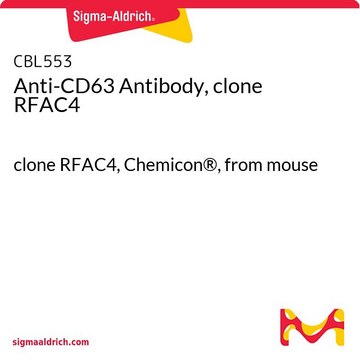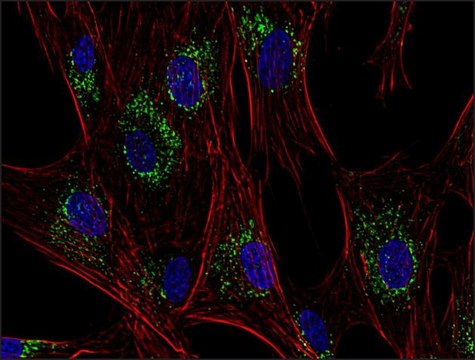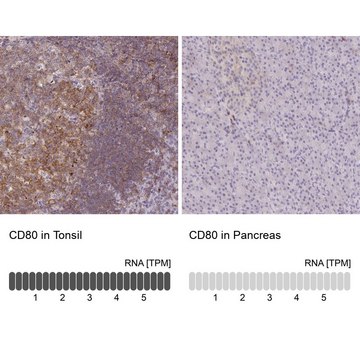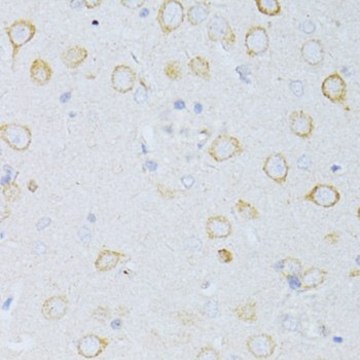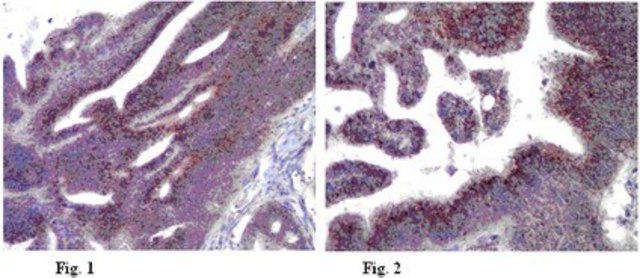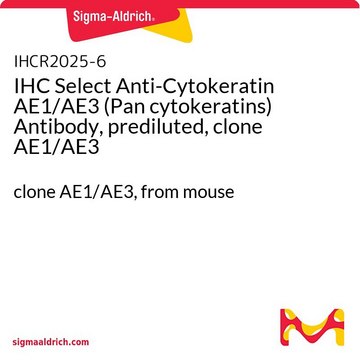MABF2159
Anti-CD63 (LAMP3) Antibody, clone ME491
clone ME491, from mouse
别名:
CD63 antigen, Granulophysin, Lysosomal-associated membrane protein 3, LAMP-3, Melanoma-associated antigen ME491, OMA81H, Ocular melanoma-associated antigen, Tetraspanin-30, Tspan-30
登录查看公司和协议定价
所有图片(2)
About This Item
UNSPSC代码:
12352203
eCl@ss:
32160702
NACRES:
NA.43
推荐产品
生物来源
mouse
抗体形式
purified immunoglobulin
抗体产品类型
primary antibodies
克隆
ME491, monoclonal
种属反应性
human
包装
antibody small pack of 25 μg
技术
flow cytometry: suitable
immunocytochemistry: suitable
immunohistochemistry: suitable (paraffin)
western blot: suitable
同位素/亚型
IgG1κ
NCBI登记号
UniProt登记号
靶向翻译后修饰
unmodified
基因信息
human ... CD63(967)
一般描述
CD63 antigen (UniProt: P08962; also known as Granulophysin, Lysosomal-associated membrane protein 3, LAMP-3, Melanoma-associated antigen ME491, OMA81H, Ocular melanoma-associated antigen, Tetraspanin-30, Tspan-30, CD63) is encoded by the CD63 (also known as MLA1, TSPAN30) gene (Gene ID: 967) in human. CD63 is a multi-pass membrane protein of the tetraspan family that is found on endosome, lysosome, and plasma membranes. CD63 has been detected in platelets, Dysplastic nevi benign moles), radial growth phase primary melanomas, hematopoietic cells, and in tissue macrophages. In melanoma cells it is involved in their motility and adhesion. CD63 also plays a role in the adhesion of leukocytes onto endothelial cells. It is reported to play a role in the activation of ITGB1 and integrin signaling, leading to the activation of AKT, FAK/PTK2 and MAP kinases and promote cell survival, reorganization of the actin cytoskeleton, cell adhesion, spreading and migration. CD63 is a highly N-glycosylated protein with three asparagine glycosylation sites (aa 130, 150, 172) and its ribophorin II (RPN2)-mediated glycosylation has been linked to breast cancer. Overexpression of CD63 has been observed in esophageal cancer that is negatively correlated with tumor stage and lymph node metastasis. Lack of expression of CD63 in platelets has been observed in a patient with Hermansky-Pudlak syndrome (HPS), an autosomal recessive disorder that is characterized by oculocutaneous albinism, bleeding due to platelet storage pool deficiency, and lysosomal storage defects. This antibody (clone ME491) is shown to react with human primary and to some extent with metastatic melanoma tissues. (Ref.: Lai, X., et al. (2017). Oncol. Let. 13(6); 4245-4251; Tominaga, N., et al. (2014). Mol. Cancer 13; 134; Smith, M., et al. (1997). Melanoma Res. 7 (Suppl. 2), 163-170).
特异性
Clone ME491 specifically detects CD63 (LAMP-3) in human cells.
免疫原
Clear supernatant from SK-Mel-23 cell lysate.
应用
Anti-CD63 (LAMP3), clone ME491, Cat. No. MABF2159, is a mouse monoclonal antibody that detects CD63 antigen and has been tested for use in Flow Cytometry, Immunocytochemistry, Immunohistochemistry (Paraffin), and Western Blotting.
Immunohistochemistry (Paraffin) Analysis: A 1:250 dilution from a representative lot detected CD63 (LAMP3) in human spleen and human bone marrow tissue sections.
Immunocytochemistry Analysis: A representative lot detected CD63 (LAMP3) in Immunocytochemistry applications (Atkinson, B., et. al. (1984). Cancer Res. 44(6):2577-81).
Flow Cytometry Analysis: A representative lot detected CD63 (LAMP3) in Flow Cytometry applications (Li, J., et. al. (2003). J Immunol. 171(6):2922-9).
Western Blotting Analysis: A representative lot detected CD63 (LAMP3) in Western Blotting applications (Smith, M., et. al. (1997). Melanoma Res. 7 Suppl 2:S163-70).
Immunohistochemistry Analysis: A representative lot detected CD63 (LAMP3) in Immunohistochemistry applications (Li, J., et. al. (2003). J Immunol. 171(6):2922-9).
Immunocytochemistry Analysis: A representative lot detected CD63 (LAMP3) in Immunocytochemistry applications (Atkinson, B., et. al. (1984). Cancer Res. 44(6):2577-81).
Flow Cytometry Analysis: A representative lot detected CD63 (LAMP3) in Flow Cytometry applications (Li, J., et. al. (2003). J Immunol. 171(6):2922-9).
Western Blotting Analysis: A representative lot detected CD63 (LAMP3) in Western Blotting applications (Smith, M., et. al. (1997). Melanoma Res. 7 Suppl 2:S163-70).
Immunohistochemistry Analysis: A representative lot detected CD63 (LAMP3) in Immunohistochemistry applications (Li, J., et. al. (2003). J Immunol. 171(6):2922-9).
Research Category
Inflammation & Immunology
Inflammation & Immunology
质量
Evaluated by Western Blotting in human platelet lysate.
Western Blotting Analysis: 2 µg/mL of this antibody detected CD63 (LAMP3) in human platelet lysate.
Western Blotting Analysis: 2 µg/mL of this antibody detected CD63 (LAMP3) in human platelet lysate.
目标描述
~43 kDa observed; 25.64 kDa calculated. Uncharacterized bands may be observed in some lysate(s).
外形
Protein G purified
Format: Purified
Purified mouse monoclonal antibody IgG1 in buffer containing 0.1 M Tris-Glycine (pH 7.4), 150 mM NaCl with 0.05% sodium azide.
储存及稳定性
Stable for 1 year at 2-8°C from date of receipt.
其他说明
Concentration: Please refer to lot specific datasheet.
免责声明
Unless otherwise stated in our catalog or other company documentation accompanying the product(s), our products are intended for research use only and are not to be used for any other purpose, which includes but is not limited to, unauthorized commercial uses, in vitro diagnostic uses, ex vivo or in vivo therapeutic uses or any type of consumption or application to humans or animals.
未找到合适的产品?
试试我们的产品选型工具.
法规信息
新产品
Philipp Rhode et al.
Cancers, 13(23) (2021-12-11)
In-depth characterization has introduced new molecular subtypes of gastric cancer (GC). To identify these, new approaches and techniques are required. Liquid biopsies are trendsetting and provide an easy and feasible method to identify and to monitor GC patients. In a
我们的科学家团队拥有各种研究领域经验,包括生命科学、材料科学、化学合成、色谱、分析及许多其他领域.
联系技术服务部门